Introduction: When it comes to creating a seamless, user-friendly environment in your home or office, the little things often make a big difference. One such small yet impactful device is the momentary decorator switch. In this comprehensive guide, I’ll take you through everything you need to know about these handy switches, based on my personal experiences and extensive research.
What is a Momentary Decorator Switch?
A momentary decorator switch is a type of electrical switch that only completes a circuit when it is pressed. Unlike traditional switches that toggle between on and off positions, momentary switches are designed for temporary activation. These switches are often used in applications where you need a momentary response, such as in buzzers, alarms, or even in controlling LED lights.
Types of Momentary Switches
- Normally Open (NO): The circuit is incomplete until the switch is pressed. Widely used for applications requiring a temporary activation.
- Normally Closed (NC): The circuit is complete until the switch is pressed, ideal for safety mechanisms or deactivating systems.
- Push Button Switches: A common type of momentary switch, these can be round or rectangular and are often used in household appliances.
Why Choose a Momentary Decorator Switch?
Momentary decorator switches offer a range of benefits, making them a popular choice in both residential and commercial settings. Here’s why you might consider installing one:
Key Advantages
- Enhanced Control: They provide precise control over devices, allowing you to activate them only when needed.
- Versatility: Momentary switches can be integrated into various systems, from lighting to alarm systems.
- Improved Safety: By reducing the risk of accidental activation, momentary switches can enhance safety in multiple applications.
- Modern Aesthetics: The sleek design of decorator switches fits modern interior styles seamlessly.

Applications of Momentary Decorator Switches
Momentary switches are incredibly versatile and can be found in a variety of applications:
- Lighting Control: Ideal for controlling dimmers or LED strip lights.
- Alarm Systems: Used in security systems for bypassing alarms or sirens.
- Home Automation: Activate devices in smart home systems through a single press.
- Appliances: Commonly used in kitchen appliances like mixers or toasters for temporary power.

Choosing the Right Momentary Decorator Switch
When selecting the perfect momentary decorator switch for your needs, consider the following factors:
Specifications
| Specification | Description |
|---|---|
| Voltage Rating | Ensure the switch can handle the voltage of your application (e.g., 120V, 240V). |
| Current Rating | Choose a switch with a current rating that matches your device’s requirements. |
| Type of Action | Decide between normally open and normally closed based on your application needs. |

Design Considerations
- Size: Ensure the switch fits into your decor without being obtrusive.
- Color: Choose colors that complement your existing decor.
- Material: Switches can be made of plastic or metal; select based on durability and look.
Installation of Momentary Decorator Switches
Installing a momentary decorator switch is a straightforward process. Here’s a step-by-step guide based on my personal experience:

Tools Required
- Wire Strippers
- Screwdriver
- Voltage Tester
- Electrical Tape
Step-by-Step Installation Process
- Turn Off the Power: Safety first! Always switch off the power at the circuit breaker before starting.
- Remove the Existing Switch: Unscrew the old switch and carefully detach the wires.
- Connect the New Switch: Match the wires to the corresponding terminals of the momentary switch (NO or NC as needed).
- Secure the Switch: Once connected, carefully tuck the wires back into the electrical box and screw the new switch in place.
- Turn the Power Back On: Restore power and test the switch to ensure it functions correctly.

Common Issues & Troubleshooting
Even though momentary decorator switches are relatively simple devices, you may encounter some issues. Here are a few common problems and tips for troubleshooting them:
Problem: Switch Not Responding
Solution: Check connections to ensure they are secure. Use a voltage tester to confirm that power is reaching the switch.

Problem: Switch Sticking
Solution: Inspect for debris or damage inside the switch. If necessary, replace it with a new one.
Problem: Unintended Activation
Solution: Ensure the switch is of the right type (NO or NC) for your application. Consider repositioning or securing it in place to prevent accidental presses.
Momentary Switch vs. Standard Switch: A Comparison
Understanding how momentary switches differ from standard toggle switches can help you make informed choices. Below is a comparative table:
| Feature | Momentary Switch | Standard Toggle Switch |
|---|---|---|
| Operation | Temporarily closes circuit while pressed | Maintains circuit state until toggled |
| Common Uses | Lighting control, alarms, automation | General on/off applications |
| Design | Sleek, modern | Variety of styles, but often bulkier |
| Feedback | Instant response | Visual indication of on/off status |
Personal Experience: My Installation Journey
Let me share a bit of my personal journey with momentary decorator switches. Last year, I decided to upgrade my home lighting system with smart dimmers. I opted for momentary switches to control the dimming feature. I was initially intimidated by the installation process, but following a clear guide and understanding the switch functionality significantly eased my concerns. Not only did I achieve the sleek look I desired, but I also felt a great sense of accomplishment after completing the installation myself!
Additional Tips from My Experience
- Always turn off electricity at the breaker before starting work.
- If you’re unsure about wiring, consult a professional to avoid potential hazards.
- Label your wires during installation to ensure correct reconnections.
FAQs About Momentary Decorator Switches
What is the difference between a momentary switch and a toggle switch?
The primary difference is that a momentary switch only activates while pressed, while a toggle switch can maintain its state until manually switched off or on.
Can momentary switches be used for home automation systems?
Yes, momentary switches can be excellent for triggering actions in home automation systems, such as turning on lights or activating scenes.
What are the safety considerations when installing a momentary switch?
Always ensure the power is off before installation, and use a voltage tester to confirm that the circuit is not live. Additionally, use appropriate wire gauges and connectors.
Are momentary switches more reliable than standard switches?
Both types can be reliable, but momentary switches can often be better for specific applications where temporary activation is required. Regular maintenance will ensure both function properly over time.
Where can I purchase momentary decorator switches?
Momentary decorator switches can be found at most hardware stores, electrical supply stores, and online retailers specializing in electrical components.
Conclusion
Momentary decorator switches may seem like a small detail in the grand scheme of home or office functionality, but they certainly pack a punch. Their versatility, safety, and modern aesthetics make them a popular choice for numerous applications. Whether you’re looking to upgrade your lighting system or ensure the temporary activation of devices, momentary switches can be a fantastic addition.
With this guide, I hope you’ve gained a deeper understanding of momentary decorator switches and feel prepared to explore their benefits for your own projects. If you have any questions or personal experiences with these switches, feel free to share below—I’d love to hear from you!